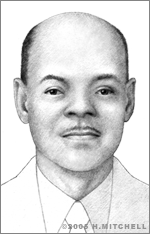Otis Boykin
African American inventor Otis F. Boykin’s work on improved electrical resistors made possible the steady workings of a variety of now-ubiquitous electronic devices. Variations of his resistor models are used around the world today in televisions, computers, and radios. Most notably, however, his work enabled control functions for the first successful, implantable pacemaker.
Boykin was born in Dallas, Texas, on August 29, 1920 to parents of modest means. His mother was a homemaker and his father was a carpenter. He graduated from Fisk University in 1941 and got a job as a laboratory assistant, testing automatic aircraft controls. In 1944, he moved on to work for the P.J. Nilsen Research Labs in Illinois. Shortly thereafter, he started his own company, Boykin-Fruth Inc.
Boykin pursued graduate studies at the Illinois Institute of Technology from 1946 to 1947, but unfortunately, he had to drop out when his family could no longer afford to pay tuition. Undeterred, Boykin began working hard on inventions of his own, with a special interest in the emerging field of electronics.
Boykin, while working as a consultant in Chicago, came up with several variations on the resistors that were commercially successful. A resistor is a crucial electronic component that impedes the flow of electrical current. Normally, a resistor is designed to have a specific amount of resistance, depending on the type of task or device it is designated for. Typically, a resistor’s value is denoted by tiny, colored bands for identification.

Boykin earned his first patent in 1959 for a wire precision resistor, which allowed for the designation of a precise amount of resistance for a specific purpose. This was followed by his 1961 patent for an electrical resistor that was both inexpensive and easy to produce. Additionally, according to U.S. patent No. 2,972,726, this resistor had the ability to “withstand extreme accelerations and shocks and great temperature changes without danger of breakage of the fine resistance wire or other detrimental effects.”
The advances incorporated into Boykin’s resistor meant that many electronic devices, including consumer goods and military equipment, could be made more cheaply and with greater reliability than provided by earlier options. His resistor was quickly incorporated into a number of products, including guided missiles and IBM computers in the United States and overseas. In addition, a version of his resistor made possible the precise regulation necessary for the success of the pacemaker, which has helped to save and lengthen the lives of thousands of men and women around the world.
Boykin’s achievements led him to work as a consultant in the United States and in Paris from 1964 to 1982. Meanwhile, he continued working on resistors until the end of his life. He created an electrical capacitor in 1965 and an electrical resistance capacitor in 1967, as well as a number of electrical resistance elements. He is also known to have created a range of consumer innovations including a burglar-proof cash register and a chemical air filter.
Boykin died of heart failure in Chicago in 1982. Over the course of his life he earned over 25 patents, his first issued in 1959 and his last in 1985.


